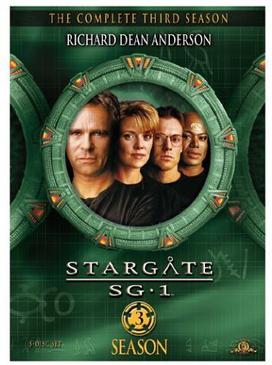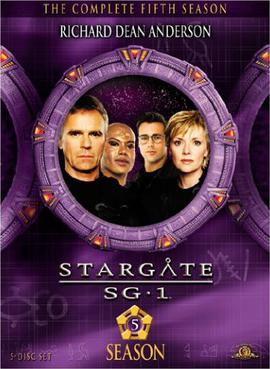Stargate SG-1 is a military science fiction adventure television series within Metro-Goldwyn-Mayer's Stargate franchise. The show, created by Brad Wright and Jonathan Glassner, is based on the 1994 science fiction film Stargate by Dean Devlin and Roland Emmerich. The television series was filmed in and around the city of Vancouver, British Columbia, Canada. The series premiered on Showtime on July 27, 1997, and moved to the Sci Fi Channel on June 7, 2002; the final episode first aired on Sky1 on March 13, 2007.

Jonathan J. "Jack" O'Neill is a fictional character in the MGM's military science fiction franchise Stargate, primarily as one of the main characters of the television series Stargate SG-1. Richard Dean Anderson played O'Neill in all the Stargate media since 1997, when he took over the role from actor Kurt Russell, who portrayed the character in the original Stargate film in 1994. O'Neill and Daniel Jackson are the only two characters to appear in both the original film and all three live-action Stargate television series.

Daniel Jackson, PhD, is a fictional character in the military science fiction franchise Stargate, and one of the main characters of the 1997 series Stargate SG-1. He is portrayed by James Spader in the 1994 film Stargate, and by Michael Shanks in Stargate SG-1 and other SG-1 derived media. Jackson is the only Stargate character to appear in all films and series in the franchise.

Teal'c of Chulak is a fictional character in the 1997 military science fiction television series Stargate SG-1. Portrayed by Christopher Judge, Teal'c is a Jaffa warrior from the planet Chulak. As a Jaffa, Teal'c is a genetically modified human with an abdominal pouch that serves as an incubator for a larval Goa'uld. The larval symbiote grants enhanced strength, health, healing, and longevity; Teal'c is around 100 years old during the show's run and ages an additional 50 years in the final SG-1 episode. Teal'c's most notable feature is a golden tattoo found on his forehead, a sign that he once served the System Lord Apophis as First Prime, the most senior Jaffa rank.
Stargate is a military science fiction media franchise based on the film directed by Roland Emmerich, which he co-wrote with producer Dean Devlin. The franchise is based on the idea of an alien wormhole device that enables nearly instantaneous travel across the cosmos. The franchise began with the film Stargate, released on October 28, 1994, by Metro-Goldwyn-Mayer and Carolco, which grossed US$197 million worldwide. In 1997, Brad Wright and Jonathan Glassner created a television series titled Stargate SG-1 as a sequel to the film. This show was joined by Stargate Atlantis in 2004, Stargate Universe in 2009, and a prequel web series, Stargate Origins, in 2018. Also consistent with the same story are a variety of books, video games and comic books, as well as the direct-to-DVD movies Stargate: Children of the Gods, Stargate: The Ark of Truth, and Stargate: Continuum, which concluded the first television show after 10 seasons.

"Wormhole X-Treme!" is the 100th episode of military science fiction adventure television show Stargate SG-1 and is the 12th episode of the fifth season. The episode was first broadcast September 8, 2001 on Showtime in the United States. It was written by series co-creator and executive producer Brad Wright along with supervising producers Joseph Mallozzi and Paul Mullie and was directed by Peter DeLuise.

"Children of the Gods" is the first episode of the military science fiction television series Stargate SG-1. It was written by producers Jonathan Glassner and Brad Wright and was directed by Mario Azzopardi. The episode first aired on July 27, 1997, on Showtime. Originally presented as a television movie, the episode would later be split into two parts for repeats and syndicated viewings. A new, updated cut, which is entitled "Children of the Gods – The Final Cut" was released on DVD on July 21, 2009 by MGM Home Entertainment.
"Within the Serpent's Grasp" is the first season finale of the science fiction television series Stargate SG-1. The episode continues on from the events of "There But for the Grace of God" and "Politics" and concludes in the season 2 opening episode "The Serpent's Lair". Written by James Crocker, showrunner Jonathan Glassner adapted the story into a teleplay, with David Warry-Smith directing. The episode first aired on March 6, 1998 on Showtime in the United States and on August 26, 1998 on Sky One in the United Kingdom.

"Lost City" is the two-part finale to the seventh season of the science fiction television show Stargate SG-1. The episode was written by Brad Wright and Robert C. Cooper, with Martin Wood directing. The first part originally premiered on March 2, 2004, with the second part showing a week later on March 9, 2004 on Sky One in the United Kingdom. SciFi Channel in the United States then aired part one on March 12, 2004 and part two on March 19, 2004.
"Window of Opportunity" is the sixth episode from season 4 of the science fiction television series Stargate SG-1, and first aired on the American subscription channel Showtime on August 4, 2000. The episode is based on a time loop scenario, with SG-1 team members Colonel O'Neill and Teal'c repeatedly reliving the same ten hours after a mission on a planet. Since the rest of their team and all personnel at Stargate Command are unaware of the happenings and do not remember the time resets, O'Neill and Teal'c are forced to find a solution on their own.

"Small Victories" is the first episode from season four of the science fiction television series Stargate SG-1. Penned by Robert C. Cooper and directed by Martin Wood, the episode first aired on the American subscription channel Showtime on June 30, 2000. "Small Victories" resumes the story of the season 3 finale, "Nemesis", in which the SG-1 team encountered the Replicators for the first time. As the Replicators threaten Earth and the Asgard home galaxy, the team must split to master their job.

Stargate: Continuum is a 2008 American military science fiction film directed by Martin Wood and written by Brad Wright. It is the second sequel to the television series Stargate SG-1, following The Ark of Truth (2008). The film stars the main cast of the series' last season, with the return of Richard Dean Anderson as Jack O'Neill.

The eighth season of Stargate SG-1, an American-Canadian military science fiction television series, began airing on July 9, 2004, on the Sci Fi channel. The eighth season concluded on February 22, 2005, after 20 episodes on British Sky One, which overtook the Sci Fi Channel in mid-season. This was the first season of the show to have 20 episodes instead of 22, as well as the first to air concurrently with Stargate SG-1 spinoff series Stargate Atlantis. The series was originally developed by Brad Wright and Jonathan Glassner, while Brad Wright and Robert C. Cooper served as executive producers. Season eight regular cast members include Richard Dean Anderson, Amanda Tapping, Christopher Judge, and Michael Shanks

The second season of Stargate SG-1, an American-Canadian television series, began airing on June 26, 1998, on Showtime. The second season concluded after 22 episodes on February 10, 1999, on British Sky One, which overtook Showtime in mid-season. The series was developed by Brad Wright and Jonathan Glassner, who also served as executive producers. Season two regular cast members include Richard Dean Anderson, Michael Shanks, Amanda Tapping, Christopher Judge, and Don S. Davis.

The third season of the military science fiction television series Stargate SG-1 commenced airing on Showtime in the United States on June 25, 1999, concluded on Sky1 in the United Kingdom on March 8, 2000, and contained 22 episodes. The third season follows SG-1 in their fight against the Goa'uld Empire's System Lords, the main being Sokar until "The Devil You Know" and then Apophis, after he regained power during that episode. The season introduces the long-unseen and unnamed enemy of the Asgards, the Replicators, who are self-replicating machines that seek to convert all civilizations into more of themselves, thus posing a dire threat to all other beings. The Replicators are first mentioned, but not named, in season three episode "Fair Game".

The fourth season of Stargate SG-1, an American-Canadian television series, began airing on June 30, 2000 on Showtime. The fourth season concluded after 22 episodes on February 14, 2001 on British Sky One, which overtook Showtime in mid-season. The series was developed by Brad Wright and Jonathan Glassner. Season four regular cast members include Richard Dean Anderson, Michael Shanks, Amanda Tapping, Christopher Judge, and Don S. Davis.

The fifth season of the military science fiction television series Stargate SG-1 commenced airing on Showtime in the United States on June 29, 2001, concluded on Sky1 in the United Kingdom on February 6, 2002, and contained 22 episodes. The fifth season introduces future main character Jonas Quinn portrayed by Corin Nemec from 2002–2004. The fifth season is about the ongoing war with the Goa'uld Empire after the death of Apophis at the start of the season and the rise of a new System Lord named Anubis. SG-1, a military-science team, are set to explore the Milky Way Galaxy.

The sixth season of Stargate SG-1, an American-Canadian television series, began airing on June 7, 2002 on Sci Fi. The sixth season concluded after 22 episodes on February 19, 2003 on the UK's Sky One, which had overtaken the Sci-Fi Channel's number of new-episode broadcasts mid-season. The series was developed by Brad Wright and Jonathan Glassner. Season six regular cast members include Richard Dean Anderson, Amanda Tapping, Christopher Judge, Corin Nemec, and Don S. Davis.














